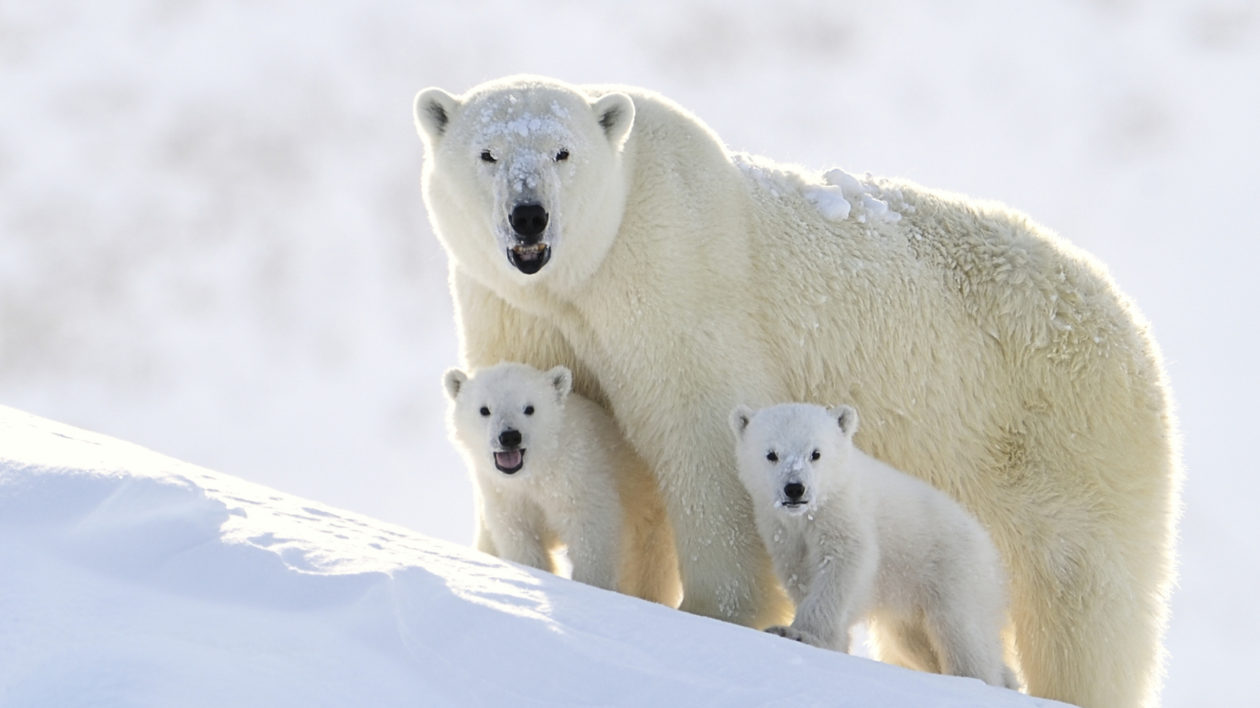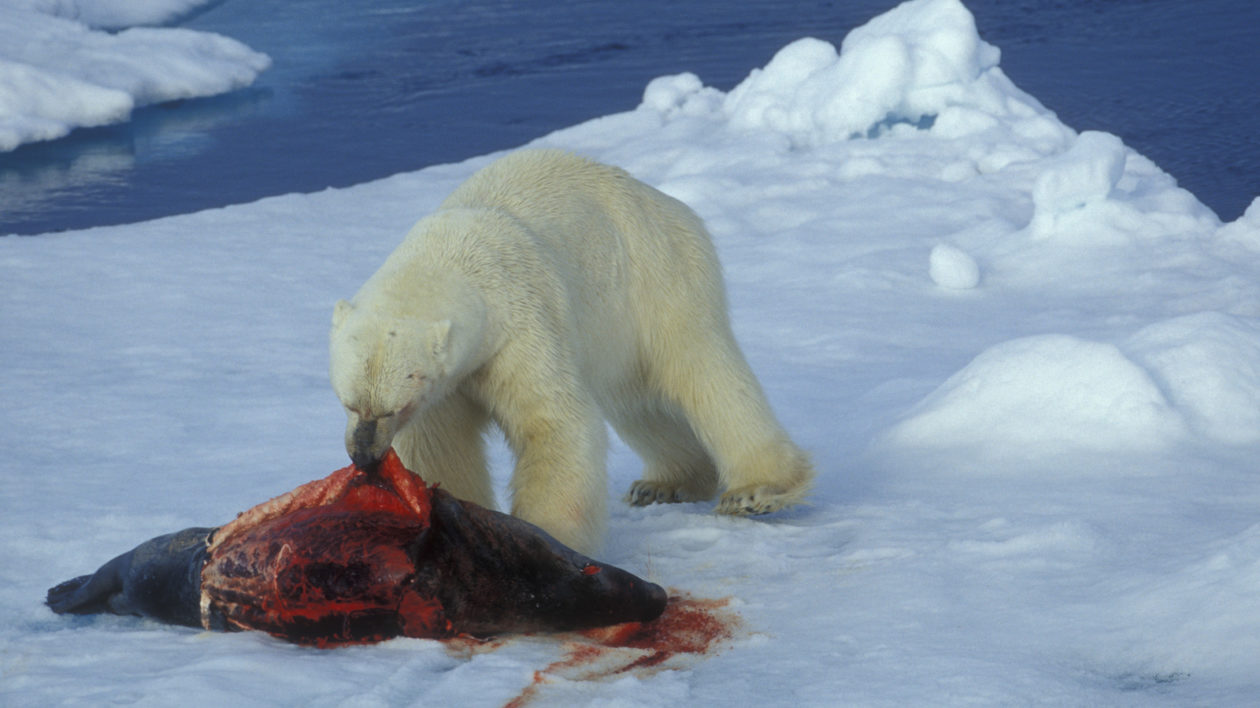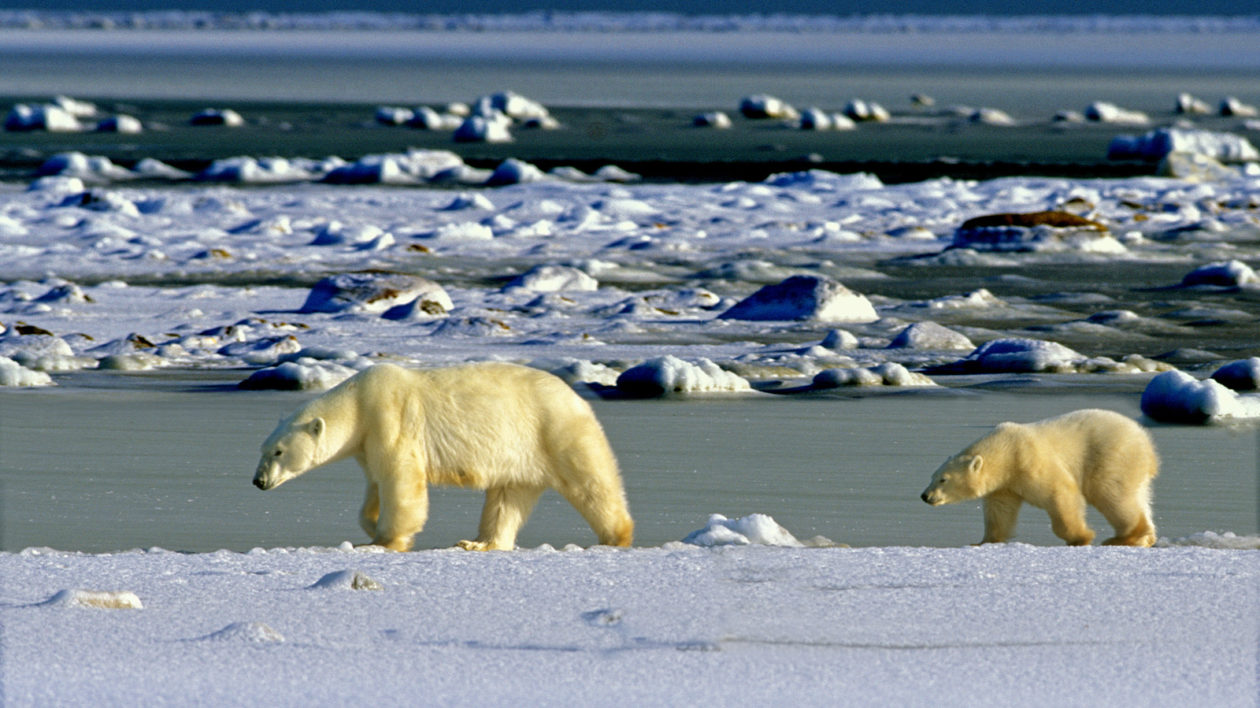You’ve probably seen the news stories lately about a remote Russian town being “invaded” by dozens of hungry, garbage-eating polar bears. These bears are roaming around playgrounds, rummaging through the local dump, and even trying to enter office buildings.
A similar incident occurred in 2016, when a sloth of polar bears — yes, that’s the proper collective name — besieged scientists at a research station in the Russian Arctic.
But these news stories don’t paint the full picture of what’s happening to the iconic white bears as climate change takes hold in the north. Are they all starving? Will polar bears go extinct? Why is sea ice so important?
The answers to these questions are complex, but we’ve boiled down the basic facts for you here.
Are Polar Bears Endangered?
Not yet, but they’re not doing great. The IUCN lists the polar bear (Ursus maritimus) as a vulnerable species, one step away from being endangered.
Scientists don’t have exact numbers on the polar bear population, because these animals are spread out over a large area of rough, inhospitable terrain and are very difficult to count. The best estimate is around 25,000 animals in Canada, the United States, Greenland, Norway, and Russia.
There are 19 different subpopulations of polar bears, and depending on where they live, some of these sub-populations are faring better than others. Some are stable, one is increasing, several are in decline, and for the rest we just don’t have good data.
Recently, a controversial report from the Canadian government said that there are too many polar bears in the Canadian Arctic, threatening the safety of Inuit peoples living there. Many scientists disagreed with those findings, stating that bears might appear more numerous because they’re coming into contact with humans more frequently.

Why is Climate Change Bad for Polar Bears?
Polar bears should really be called ice bears, because ice is key to their survival.
The majority of a polar bear’s diet is made up of seals that live on and around the edge of the sea ice, like ringed seals and bearded seals. Polar bears hunt on the ice, stalking seals as they lounge on icebergs or surface for air at a breathing hole.
The extent of the sea ice changes throughout the year. It reaches its peak in late winter, around the end of March, and then shrinks during the warmer summer months. As the ice melts, polar bears rely more and more on the fat stores they built up during the previous winter. By September the sea ice is at its lowest and bears often struggle to find enough food. Then as winter comes the ice grows, allowing polar bears to hunt more easily.
This reliance on sea ice makes polar bears extremely vulnerable to climate change. The Arctic is warming faster than most other places on earth, and as it warms there’s less and less ice. From 1979 to 2011, the amount of sea ice left in September declined by 14 percent per decade. Sea ice is declining even faster than climate models predict.
Each year the ice takes longer to form, covers less area, and melts faster. Polar bears have less time to hunt on the ice and build up fat reserves for summer, and they must survive on those stores for longer as they wait for the ice to return. Starvation is a risk, and scientists are also concerned that bears will be less likely to breed and have cubs if they can’t find enough food.
Climate change is the single greatest threat to polar bears. Declining sea ice not only deprives bears of their hunting grounds, it also exacerbates other threats. Less ice means that more of the Arctic will be open to oil drilling, commercial shipping, pollution, tourism, and even hunting. These problems already threaten polar bears, and with climate change they will likely get worse.

Are Polar Bears Starving?
Yes, but not all of them. Not yet.
About a year ago, a video of a starving polar bear transfixed the internet. Shot by photographer Paul Nicklen, the footage showed an emaciated polar bear stumbling about incoherently, hours away from death. It’s impossible to say that climate change caused this particular bear to starve to death.
But as the sea ice disappears, more and more bears may suffer this fate.
Shrinking ice means the polar bears have less time to hunt and build up fat reserves. It also means they have to travel farther to find their next meal, burning more calories and further depleting their fat stores. Bears may have to swim greater distances between ice packs, which puts little cubs at risk of drowning.
Polar bears are even more reliant on a diet of fat-rich seals than scientists previously thought. In one study, researchers used Fitbit-like activity monitors and GPS collars with cameras to monitor bears’ activity and hunting over a 8 to 10 day period. They calculated that an adult polar bear needs to eat at least one adult ringed sea (or three juveniles) every 10 days. Four bears in the study didn’t meet that baseline, and in less than 2 weeks they lost almost 10 percent of their body mass, or about 40 pounds.

Unfortunately, hunting different prey on land isn’t enough to feed a hungry bear. In the lean summer months, bear do supplement their diet with food like caribou, berries, or bird eggs. But these foods don’t have enough calories to help bears build up their fat reserves, because bears have to expend more energy to find them.
It’s worth noting that — at least right now — not all polar bear populations are struggling to find food. Some parts of the Arctic still have year-round pack ice, while other areas are completely ice-free for several months. Nicklen, the photographer who captured the footage of the starving bear on Canada’s Baffin Island, told National Geographic that he has seen bears in Russia that are so fat they can barely walk. It all depends on the ice.
In places where the ice is disappearing fastest, bears are more and more likely to come into contact with people. The Russian town of Belushya Guba recently declared a state of emergency after an influx of more than 50 polar bears descended on the town in search of food. Photos show dozens of adults bears and cubs scavenging in the town’s rubbish dump and wandering playgrounds.
So just how many bears are starving right now? We don’t know. The Arctic is just too remote and too vast to monitor polar bears so closely. But Nicklen’s video and the ongoing invasion in Belushya Guba paint a worrying picture of what is to come as the sea ice slips away.

Will Polar Bears Go Extinct?
Maybe.
There are so many variables at play that scientists can’t say for certain if climate change will doom polar bears to extinction. But we do know that climate change will drastically and rapidly reduce the habitat that these bears need to survive. And that doesn’t bode well for bears.
A study on the Canadian Arctic Archipelago found that, under business-as-usual climate projections, polar bears may face starvation and reproductive failure across the region by the year 2100. Studies also show that polar bear populations will become more fragmented as ice declines, threatening their genetic health.
Another possible fate — and threat — is that polar bears will crossbreed with grizzly bears. Grizzly bears are venturing further and further north — likely because of climate change — bringing them into contact with polar bears.
Polar bears actually evolved from grizzly bears about 150,000 years ago, and they can still breed with this other species successfully. In the past 20 years, scientists and hunters have found a handful of polar-grizzly hybrids, called “pizzly” or “grolar” bears. While it’s not a widespread problem yet, conservationists worry that both hybridization and general competition with grizzlies could threaten polar bears in the future.

Can We Do Anything To Help?
Unfortunately, there are no quick fixes to save the polar bear.
Some people have raised the idea of relocating bears to Antarctica, or for feeding wild bears to help fight starvation. Both ideas are extremely problematic, expensive, and could cause lasting ecological harm for other species.
At the end of the day, these are just temporary solutions — the only way to protect polar bears long-term is to reduce greenhouse gas emissions. (You can read more about The Nature Conservancy’s efforts to fight climate change here.)




I liked the pictures and the questions by them in bold
hi, I really really want o know if global warming is going to affect polar bears in the future so please reply
my email: skvandermeul@cps.edu
thank you,
Skylar Vander Meulen